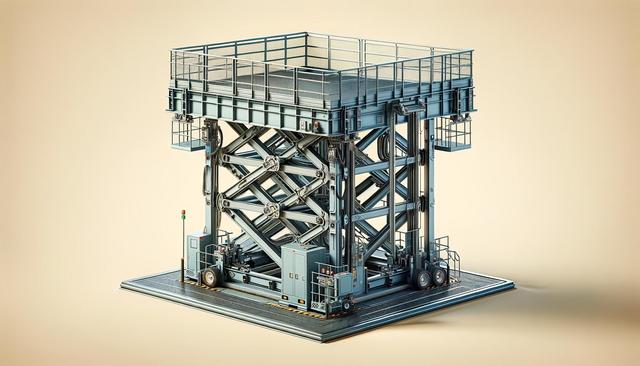Understanding Hydraulic Platform Lifts
Hydraulic platform lifts are mechanical devices used to raise or lower people and materials across vertical distances. These systems utilize fluid pressure to operate a cylinder and piston mechanism, which provides the lifting force. Often found in commercial buildings, warehouses, and even residential settings, hydraulic lifts are valued for their steady operation and ability to handle substantial weight. The core principle behind these lifts is Pascal’s Law, where pressure applied to a fluid in a confined space is transmitted equally in all directions.
These lifts are available in several configurations, including scissor lifts, vertical platform lifts, and dock lifts, each serving a specific purpose. They are commonly used in scenarios where elevators might not be practical or cost-effective. The adaptability of hydraulic platform lifts makes them suitable for both indoor and outdoor installations, and they are especially popular in retrofit applications where structural changes need to be minimized.
Key Components and How They Work
A typical hydraulic platform lift consists of several main components that work together to ensure safe and efficient operation:
- Hydraulic Pump: Powers the system by pressurizing hydraulic fluid.
- Hydraulic Cylinder: Converts the fluid pressure into linear motion.
- Platform: The surface on which people or materials are transported.
- Control System: Allows users to operate the lift with precision.
- Safety Mechanisms: Includes emergency stop buttons, pressure relief valves, and anti-slip surfaces.
When activated, the hydraulic pump sends fluid into the cylinder, forcing the piston to rise and elevate the platform. To lower the platform, the fluid is released back into the reservoir, allowing gravity to bring the platform down gently. This system ensures smooth and controlled movement, even under heavy loads. Maintenance primarily involves checking fluid levels, inspecting hoses for leaks, and ensuring that all mechanical parts are functioning correctly.
Applications Across Various Industries
Hydraulic platform lifts are used in a wide range of industries due to their versatility and reliability. In commercial settings, they are commonly installed in retail stores to facilitate accessibility between floors. Warehouses and distribution centers use them for loading and unloading goods, while residential buildings may incorporate smaller versions for accessibility purposes.
Some typical applications include:
- Loading docks and freight handling
- Accessibility solutions in public and private buildings
- Vehicle maintenance and repair facilities
- Stage and event production for equipment handling
The ability to customize these lifts to suit specific operational needs makes them a practical choice for many businesses. Additionally, they can be designed to meet local safety and accessibility regulations, which is critical for compliance and user safety.
Advantages of Hydraulic Platform Lifts
One of the main reasons hydraulic platform lifts are widely adopted is the range of benefits they offer. These include ease of installation, cost-effectiveness, and high load-bearing capacity. Unlike traction-based systems, hydraulic lifts do not require overhead machinery, which means they can be installed in buildings with height or space limitations.
Some notable advantages include:
- Quiet and smooth operation
- Lower maintenance requirements compared to other systems
- Highly adaptable to different architectural constraints
- Energy-efficient, especially when descending
- Reliable in low-usage environments
Moreover, hydraulic systems are known for their longevity and durability. With proper maintenance, these lifts can serve reliably for many years. They are also less susceptible to breakdowns caused by mechanical wear, making them a dependable choice for businesses that require consistent vertical movement solutions.
Considerations Before Installation
Before installing a hydraulic platform lift, several factors need to be evaluated to ensure optimal performance and safety. First and foremost is the intended use — whether the lift will be transporting people, goods, or both. This determines the size, weight capacity, and type of lift most appropriate for the space.
Other key considerations include:
- Available space for installation and operation
- Weight and frequency of expected loads
- Compliance with local building and safety codes
- Budget constraints and long-term maintenance costs
It’s also important to work with a qualified installer who can assess the site, recommend suitable models, and ensure proper setup. Safety features such as emergency lowering systems, overload protection, and secure guarding should be integral to the design. Choosing the right lift not only enhances operational efficiency but also ensures a safe environment for users and equipment.
Conclusion: A Dependable Choice for Vertical Mobility
Hydraulic platform lifts provide a safe, efficient, and versatile solution for vertical mobility needs in various environments. Whether used in commercial, industrial, or residential settings, these systems offer a practical alternative to traditional elevators, especially where space or budget constraints exist. By understanding their operation, applications, and installation factors, stakeholders can make informed decisions that align with both functional requirements and safety standards. For businesses and property owners aiming to improve access and workflow, hydraulic platform lifts remain a well-regarded and dependable option.




Leave a Reply